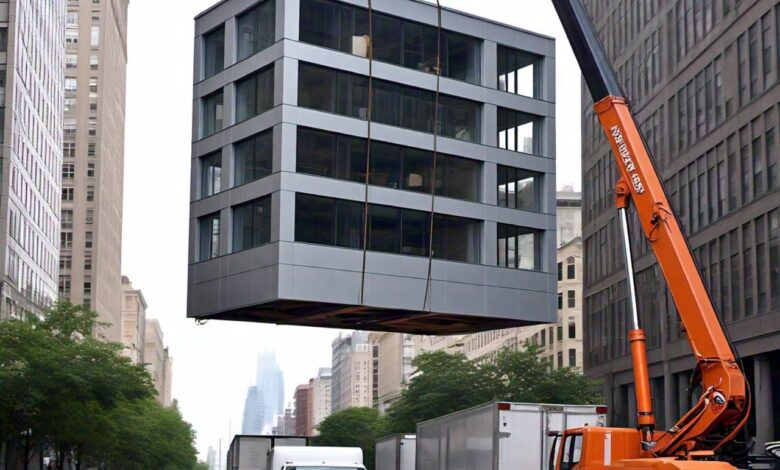Minimizing Downtime: The Advantages of Commercial Building Relocation for Your Business

In today’s fast-paced business environment, companies must continuously adapt to remain competitive. Relocating to a new commercial building can be a strategic move, whether to expand operations, tap into a new market, or streamline logistics. However, the thought of commercial building relocation often sparks concerns about downtime, disruptions, and associated costs. The truth is, when planned and executed properly, relocation can minimize downtime and bring significant advantages to your business.
The Importance of Minimizing Downtime During Relocation
Downtime during relocation is more than just an inconvenience—it can result in lost revenue, reduced employee productivity, and damage to customer relationships. With careful planning and a focus on efficiency, businesses can limit interruptions and keep operations running smoothly. Here’s how commercial building relocation can become an opportunity rather than a challenge.
Advantages of Commercial Building Relocation
Access to Better Facilities
One of the primary reasons businesses opt for relocation is the opportunity to upgrade their facilities. Modern commercial buildings often come equipped with advanced infrastructure, energy-efficient systems, and ample space for growing teams. These improvements can lead to enhanced productivity and reduced operational costs.
For example, moving into a building with better technology capabilities, such as faster internet or integrated smart systems, can streamline communication and improve overall efficiency.
Strategic Location Benefits
Relocating to a more strategic location can significantly impact your business’s visibility and accessibility. For instance, relocating a commercial building to a thriving business district can attract more clients and provide better networking opportunities. Similarly, moving closer to suppliers or key customers can reduce shipping times and logistics costs.
In retail, moving to a high-traffic area can increase footfall, while manufacturers relocating closer to distribution hubs can save on transportation expenses.
Cost Savings Over Time
While relocation involves upfront costs, it can lead to substantial long-term savings. Leasing or purchasing a newer building with energy-efficient designs and low maintenance requirements can reduce utility bills and upkeep expenses. Additionally, relocating to an area with lower property taxes or operational costs can free up resources to reinvest in your business.
Pro Tip: Evaluate the potential cost savings of relocation against the initial investment to ensure a positive return on your move.
Improved Employee Morale and Retention
A comfortable, well-designed workspace has a profound effect on employee morale. Moving to a building with modern amenities, ergonomic designs, and better commuting options can boost job satisfaction and productivity.
When employees feel valued and supported, they are more likely to stay loyal to the company. In fact, some businesses use relocation as an opportunity to implement open-office layouts, collaborative spaces, or wellness zones, which can foster a positive work culture.
Enhanced Branding Opportunities
Your building’s location and design reflect your brand. Relocating to a prestigious address or a contemporary office space can enhance your company’s image and reputation. Customers, partners, and investors often associate high-quality facilities with professionalism and success.
Take advantage of your relocation to redesign your branding elements—such as signage, office interiors, or customer-facing spaces—to align with your corporate vision.
Scalability for Growth
If your current space no longer supports your company’s growth, relocation can be the perfect solution. A larger building or one with adaptable layouts allows you to scale your operations without constraints.
By planning for future needs—such as adding workstations, expanding storage, or integrating new technologies—you can avoid repeated moves and position your business for sustained growth.
How to Minimize Downtime During Relocation
Relocation doesn’t have to disrupt your operations. Here are some proven strategies to ensure a smooth transition:
Plan Early and Set Clear Goals
Start planning months in advance. Define your objectives for the move—whether it’s reducing costs, improving facilities, or expanding operations—and establish a timeline for each phase of the relocation.
Choose the Right Partner
Work with professional commercial building relocation specialists who understand the complexities of moving businesses. Experienced movers can help with packing, logistics, and installation, ensuring that the process is as seamless as possible.
Maintain Communication
Keep employees, clients, and suppliers informed about the relocation timeline. Regular updates via email or meetings can address concerns and ensure that everyone is aligned with the plan.
Implement a Phased Move
Consider relocating in phases, especially for large organizations. This approach allows certain departments to remain operational while others move, minimizing disruptions.
Test Technology Beforehand
Set up and test your IT systems, internet connections, and phone lines at the new location before the official move. This ensures that there are no delays in communication once you’re operational.
Schedule the Move Strategically
Plan your move during off-peak hours or weekends to avoid disrupting business operations. This approach can also reduce the stress on employees and prevent delays.
Case Study: A Successful Commercial Building Relocation
XYZ Tech Solutions, a mid-sized software company, recently relocated from a suburban office park to a modern downtown high-rise. The move was motivated by the need for better infrastructure and closer proximity to key clients.
Through meticulous planning, XYZ Tech Solutions completed the relocation over a long weekend, minimizing downtime to just one business day. Their new office now boasts state-of-the-art IT infrastructure, collaborative workspaces, and a prestigious address that has helped attract both clients and top talent.
Challenges of Relocation and How to Overcome Them
While the advantages of commercial building relocation are clear, challenges like logistical hiccups, employee resistance, and unforeseen costs can arise. Here’s how to tackle these obstacles:
- Challenge: Unforeseen Costs
- Solution: Create a comprehensive budget that includes contingency funds for unexpected expenses.
- Challenge: Employee Resistance
- Solution: Involve employees in the relocation process by gathering feedback and addressing concerns.
- Challenge: Operational Disruptions
- Solution: Work with a relocation team to create a detailed plan for minimizing downtime.
Post-Relocation: Steps to Ensure a Smooth Transition
Once the move is complete, there are additional steps to take to ensure your business runs smoothly in the new location:
- Organize the Workspace: Unpack and arrange the office to ensure functionality and comfort.
- Update Your Information: Notify clients, vendors, and partners of your new address and update your online presence.
- Celebrate the Move: Host an open house or celebration to boost morale and mark the occasion.
Relocation as a Catalyst for Growth
Commercial building relocation may seem daunting, but with proper planning and execution, it can be a stepping stone to growth and success. The benefits—ranging from better facilities and cost savings to improved employee satisfaction and branding—far outweigh the temporary challenges.
If your business is considering relocation, now is the time to take action. Embrace the opportunity to reposition your company for a brighter, more prosperous future.



